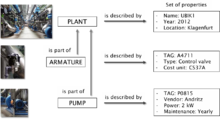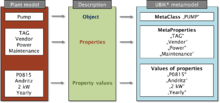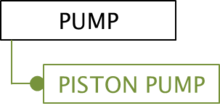Difference between revisions of "Entity Data Model"
| (9 intermediate revisions by the same user not shown) | |||
| Line 1: | Line 1: | ||
| − | Get to know about the relational data- and object model used in | + | Get to know about the relational data- and object model used in {{UBIK}} beginning from a rather figurative and abstract point of view. We will introduce the essential parts of the object model and show how these items are connected to a real system. |
==Introduction== | ==Introduction== | ||
===Objectives=== | ===Objectives=== | ||
| Line 53: | Line 53: | ||
<strong> | <strong> | ||
| − | {{ | + | {{check_mark}} Theoretical blocks representing the parts of the system |
| − | {{ | + | {{check_mark}} Necessary properties of these blocks |
</strong> | </strong> | ||
| − | An important aspect of the datamodel has not been discussed yet, namely <b>how are the blocks (=MetaClasses) related to each other?</b> | + | An important aspect of the datamodel has not been discussed yet, namely <b>how are the blocks (=[[MetaClass|MetaClasses]]) related to each other?</b> |
== Relating objects == | == Relating objects == | ||
[[File:IL_DOM_004.png|thumb|220px|alt=Relations of plant parts|Possible relations between parts of plant]] | [[File:IL_DOM_004.png|thumb|220px|alt=Relations of plant parts|Possible relations between parts of plant]] | ||
| − | Assuming that all three pumps are clearly parts of the plant „UBIK1“, the descriptive model has to be extended in order to include this information as well. In our "table" view we account for this by adding a property to the | + | Assuming that all three pumps are clearly parts of the plant „UBIK1“, the descriptive model has to be extended in order to include this information as well. In our "table" view we account for this by adding a property to the ''PUMP'' block refering to the plant. This additional property represents the link information between the pumps #1 - #3 and the plant „UBIK1“. |
<table> | <table> | ||
| Line 87: | Line 87: | ||
| − | Now we introduce two armatures with the properties from the descriptive model above. Assume that, due to the piping, pumps #1 and #2 are controlled by both armatures, whereas A200 regulates pump #3 only. This situation is depicted below already indicating, that the implementation of the relation requires a more complex structure. We find three pumps on the left side and two armatures on the right side of the relation, respectively. Managing this control relation in the Metamodel requires to introduce a relation block | + | Now we introduce two armatures with the properties from the descriptive model above. Assume that, due to the piping, pumps #1 and #2 are controlled by both armatures, whereas A200 regulates pump #3 only. This situation is depicted below already indicating, that the implementation of the relation requires a more complex structure. We find three pumps on the left side and two armatures on the right side of the relation, respectively. Managing this control relation in the Metamodel requires to introduce a relation block ''CONTROL'' with two MetaProperties „Armature#“ and „Pump#“ |
<table> | <table> | ||
| Line 173: | Line 173: | ||
===Entity Relationship Model (ER model)=== | ===Entity Relationship Model (ER model)=== | ||
[[File:IL_DOM_007.png|thumb|220 px|alt=ER-model|Entitiy-Relationship-Model]] | [[File:IL_DOM_007.png|thumb|220 px|alt=ER-model|Entitiy-Relationship-Model]] | ||
| − | In software engineering, such an abstract descriptive model is called Entity–Relationship model (ER model) and describes the entities (={{UBIK}} MetaClasses) and relationships between them. Usually this information is depicted in an entity-relationship-diagram (ERD), which draws the corresponding data objects and relations as rectangles and lines between them, respectively. The MetaClass '' | + | In software engineering, such an abstract descriptive model is called Entity–Relationship model (ER model) and describes the entities (={{UBIK}} MetaClasses) and relationships between them. Usually this information is depicted in an entity-relationship-diagram (ERD), which draws the corresponding data objects and relations as rectangles and lines between them, respectively. The MetaClass ''CONTROL'' can be drawn as diamond, signalling the additional block between these two MetaClasses, which is always needed for each relation of cardinality n : n. |
===About References and Relations=== | ===About References and Relations=== | ||
| Line 187: | Line 187: | ||
Congratulations, we integrated another important issue in our data- and object model: | Congratulations, we integrated another important issue in our data- and object model: | ||
| − | {{ | + | {{check_mark}} <b>Relationships between blocks (MetaClasses)</b> |
==MetaClasses and Instances== | ==MetaClasses and Instances== | ||
| Line 310: | Line 310: | ||
==Conclusion== | ==Conclusion== | ||
| − | + | * The descriptive model consists of '''MetaClasses''' and '''MetaProperties''' and relations between these objects. | |
| − | The descriptive model consists of '''MetaClasses''' and '''MetaProperties''' and relations between these objects | + | * Each MetaClass is defined by |
| + | ** a collection of MetaProperties | ||
| + | ** the line of inheritance | ||
| + | ** classification information | ||
| + | * A MetaProperty implements different features and settings. | ||
| + | * In this MetaModel we explicitely distinguish between the description (structure, relations,…) and '''instances''' (actual occurences) of data objects | ||
| + | * The MetaClasses might be on an equal hierarchy level from the descriptive point of view, whereas the instances are then related using '''references''' and '''relations''' | ||
| − | + | [[Category:UBIK|Entity Data Model]] | |
| − | + | ||
| − | + | ||
| − | + | ||
| − | + | ||
| − | + | ||
| − | + | ||
| − | + | ||
| − | + | ||
| − | + | ||
| − | + | ||
| − | + | ||
| − | + | ||
| − | + | ||
Latest revision as of 13:14, 30 July 2015
Get to know about the relational data- and object model used in UBIK® beginning from a rather figurative and abstract point of view. We will introduce the essential parts of the object model and show how these items are connected to a real system.
Contents
Introduction
Objectives
In an industrial environment we quite often need to
- describe an industrial plant consisting of a bunch of different parts, each having a certain purpose and set of properties, and which are related in various ways
- manage process or maintenance data of the plant and its features
- do a high-performance cost-benefit analysis and create key performance indicators
Therefore we need to
→ „Dissemble“ the system into theoretical blocks representing the real as well as intangible parts of the system.
→ Identify the necessary properties of the blocks.
→ Think about how blocks are possibly related to each other.
→ Think about the functions and features of blocks.
Plant picture
Lets start with a simple picture and assume that our plant consists of a pump and an armature. Both equipments exhibit certain technical or other properties, which our datamodel must contain in some form. Additionally the datamodel has to provide mechanism to indicate the circumstances that both equipments are parts of the plant and maybe even be related to each other.
In this first exemplary plant, we take account of a pump and armature and find definitions as shown in the picture on the right. Looking closer at the PUMP block reveals its properties and property values, this information is explicitely depicted as
Of course, a real plant consists of multiple pumps, each described with the same set of properties (TAG, vendor, power, maintenance data). The real pumps in the plant are distinguished by different property values as given in the table.
| Pump | TAG | Vendor | Power | Maintenance |
|---|---|---|---|---|
| #1 | P0815 | Andritz | 2 kW | Yearly |
| #2 | P0816 | Andritz | 5 kW | Monthly |
| #3 | P0817 | Sulzer | 4 kW | Yearly |
We can redefine or extend our objectives by
- Design a descriptive model including all required blocks and properties of the system
- Specify the possible properties for the parts of the real system
From the plant picture to UBIK®
Transition
The transition from the plant picture into an object- / data - model logically happens via an intermediate layer and finally leads to our first definition
- UBIK® MetaModel
- A descriptive model, where objects provide information about the aspects of the data, is also called “Metamodel”.
So far we have identified
![]() Theoretical blocks representing the parts of the system
Theoretical blocks representing the parts of the system
![]() Necessary properties of these blocks
Necessary properties of these blocks
An important aspect of the datamodel has not been discussed yet, namely how are the blocks (=MetaClasses) related to each other?
Relating objects
Assuming that all three pumps are clearly parts of the plant „UBIK1“, the descriptive model has to be extended in order to include this information as well. In our "table" view we account for this by adding a property to the PUMP block refering to the plant. This additional property represents the link information between the pumps #1 - #3 and the plant „UBIK1“.
 |
|
|
- UBIK® MetaModel
- Add a metaproperty „Plant“ to the MetaClass „Pump“, where the values of the MetaProperty refer to the plant „UBIK1“.
Now we introduce two armatures with the properties from the descriptive model above. Assume that, due to the piping, pumps #1 and #2 are controlled by both armatures, whereas A200 regulates pump #3 only. This situation is depicted below already indicating, that the implementation of the relation requires a more complex structure. We find three pumps on the left side and two armatures on the right side of the relation, respectively. Managing this control relation in the Metamodel requires to introduce a relation block CONTROL with two MetaProperties „Armature#“ and „Pump#“
 |
|
 |
- UBIK® MetaModel
- Managing the control relation in the Metamodel requires to introduce a relation block „CONTROL“ with two MetaProperties „Armature#“ and „Pump#“.
Lets have a closer look at the characteristics of the two methods relating objects:
- UBIK® MetaModel
- Data model built and described by MetaClasses and MetaProperties related to each other, either by 1 : n or n : n cardinality.
Entity Relationship Model (ER model)
In software engineering, such an abstract descriptive model is called Entity–Relationship model (ER model) and describes the entities (=UBIK® MetaClasses) and relationships between them. Usually this information is depicted in an entity-relationship-diagram (ERD), which draws the corresponding data objects and relations as rectangles and lines between them, respectively. The MetaClass CONTROL can be drawn as diamond, signalling the additional block between these two MetaClasses, which is always needed for each relation of cardinality n : n.
About References and Relations
Concluding and summarizing the above discussion we finally depict the two possible types of relation in the UBIK® Metamodel.
- UBIK® MetaModel
- 1 : n relationships are called “References” (one pump refers to exactly one plant)
- n : n relationships are called “Relations” (two pumps are controlled by two armatures, one pump is controlled by one armature)
Congratulations, we integrated another important issue in our data- and object model:
![]() Relationships between blocks (MetaClasses)
Relationships between blocks (MetaClasses)
MetaClasses and Instances
So far MetaClasses define the structure of and possible relations between the objects in our data model. In the next step it will be shown how to create actual objects of these blueprints and how to deal with it.
Instances
Populating our data modell with real data from a plant means, that we create objects as defined by the MetaClasses. These objects are called instances, and leads us to the next definition.
- UBIK® MetaModel
An instance is the actual „existing“ occurrence of the described object (within the metamodel). The instances can be differentiated by their property values.
MetaClass & MetaProperties
In the similar way as MetaClasses are related to each other, MetaProperties are related to MetaClasses. Hence, we obviously find that
- a MetaProperty can be related to multiple MetaClasses
- be used multiple times for defining a MetaClass' structure
- UBIK® MetaModel
- MetaProperties are assigned to a MetaClasses via relations
MetaClass & Inheritance
We can build up a hierarchical tree of MetaClasses, where MetaClasses inherit properties.
|
|||||||||||||||||||||||||||||
|
|
- UBIK® MetaModel
- MetaClasses pass on MetaProperties to child-MetaClasses („Inheritance“)
MetaClass & Classification
MetaClasses can specify features and properties of other MetaClasses by using a "Classification" technique. The result can be described by
- "A piston pump is a pump and an element of the fluid technology." [gen]
- "Piston pump" is a child MetaClass of „Pump“ and classified as "Fluid technology" object. [techn.]
- UBIK® MetaModel
- MetaClasses can specify features of other MetaClasses ("Classification")
MetaProperties
Each MetaProperty can be specified by its own attributes which are well-known from other systems.
|
|
- UBIK® MetaModel
- MetaProperties have specific attributes, closely related to the intended property value
Conclusion
- The descriptive model consists of MetaClasses and MetaProperties and relations between these objects.
- Each MetaClass is defined by
- a collection of MetaProperties
- the line of inheritance
- classification information
- A MetaProperty implements different features and settings.
- In this MetaModel we explicitely distinguish between the description (structure, relations,…) and instances (actual occurences) of data objects
- The MetaClasses might be on an equal hierarchy level from the descriptive point of view, whereas the instances are then related using references and relations









